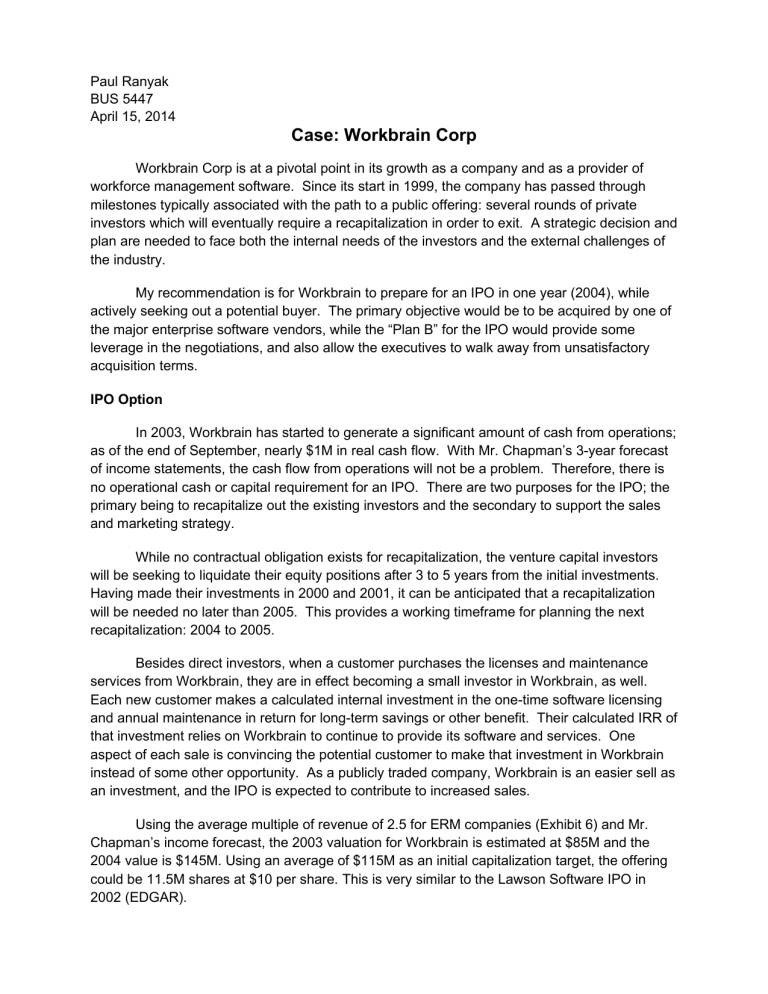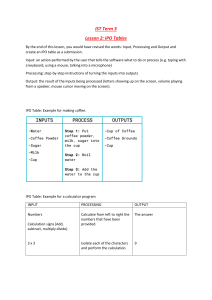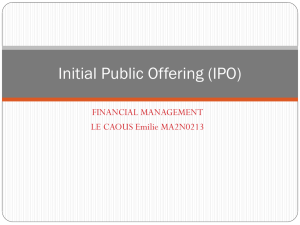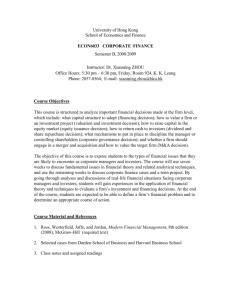
Paul Ranyak BUS 5447 April 15, 2014 Case: Workbrain Corp Workbrain Corp is at a pivotal point in its growth as a company and as a provider of workforce management software. Since its start in 1999, the company has passed through milestones typically associated with the path to a public offering: several rounds of private investors which will eventually require a recapitalization in order to exit. A strategic decision and plan are needed to face both the internal needs of the investors and the external challenges of the industry. My recommendation is for Workbrain to prepare for an IPO in one year (2004), while actively seeking out a potential buyer. The primary objective would be to be acquired by one of the major enterprise software vendors, while the “Plan B” for the IPO would provide some leverage in the negotiations, and also allow the executives to walk away from unsatisfactory acquisition terms. IPO Option In 2003, Workbrain has started to generate a significant amount of cash from operations; as of the end of September, nearly $1M in real cash flow. With Mr. Chapman’s 3-year forecast of income statements, the cash flow from operations will not be a problem. Therefore, there is no operational cash or capital requirement for an IPO. There are two purposes for the IPO; the primary being to recapitalize out the existing investors and the secondary to support the sales and marketing strategy. While no contractual obligation exists for recapitalization, the venture capital investors will be seeking to liquidate their equity positions after 3 to 5 years from the initial investments. Having made their investments in 2000 and 2001, it can be anticipated that a recapitalization will be needed no later than 2005. This provides a working timeframe for planning the next recapitalization: 2004 to 2005. Besides direct investors, when a customer purchases the licenses and maintenance services from Workbrain, they are in effect becoming a small investor in Workbrain, as well. Each new customer makes a calculated internal investment in the one-time software licensing and annual maintenance in return for long-term savings or other benefit. Their calculated IRR of that investment relies on Workbrain to continue to provide its software and services. One aspect of each sale is convincing the potential customer to make that investment in Workbrain instead of some other opportunity. As a publicly traded company, Workbrain is an easier sell as an investment, and the IPO is expected to contribute to increased sales. Using the average multiple of revenue of 2.5 for ERM companies (Exhibit 6) and Mr. Chapman’s income forecast, the 2003 valuation for Workbrain is estimated at $85M and the 2004 value is $145M. Using an average of $115M as an initial capitalization target, the offering could be 11.5M shares at $10 per share. This is very similar to the Lawson Software IPO in 2002 (EDGAR). An alternate valuation method would be to use a multiple of an income value, recommended by the Inc Magazine (2009) valuation guide. For the category of “Computer Systems Design”, the guide recommends using a multiple of 3.1 times the gross income, which for 2003 estimate would give a valuation of $53M and for 2004, $89M. These lower values are most likely due to the recessionary economic period of 2009. Strategic Concerns While Workbrain’s success is clear and validated by its sales growth, they run the risk of painting themselves into a corner. Their number one direct competitor appears to be Kronos, which actually targets businesses in the 1,200 to 2,500 employee range, as compared to Workbrain’s target market of companies with more than 5,000 employees. Kronos has over 40,000 customers world-wide, so the area of greatest sales and growth opportunity for Workbrain is larger companies. This large competitor limits Workbrain’s ability to expand downward into the smaller company market. Looking at the addressable market of large companies reveals factors that may impact the growth opportunities for Workbrain. This market is finite and the competition is stiff for those large customers’ dollars. Moving into this market from the bottom is Kronos, with more than 50% of the Fortune 1000 companies already as customers. Moving into this market laterally are the large enterprise software companies like SAP and Oracle. Workbrain runs the risk of a diminishing field of sales prospects as this market becomes more saturated and the companies adopt workforce management products. Mr. Chapman is aware that the key to this target market is breaking through the 50% market share and thus becoming the de facto standard for this software category. In order to compete with the larger enterprise companies, Workbrain must behave and market like those companies, which is why a heavy investment in product offering and marketing is essential to pursue that strategy. However, looking at the size of the competing vendors, Workbrain is a small startup, and its comparatively small valuation indicates that its competitors have much greater capacity to pursue this market. To assess the risk of achieving the 50% market share in the large company target market, consider the valuation of Workbrain compared to its competitors. As stated earlier, the 2003 valuation is estimated at $85M. Workbrain is around 8% the size of Kronos (at $1B TEV) and 0.3% the size of SAP. The risk of not achieving the 50% market share is very high, based solely on capacity. Mergers and Acquisitions Considering the risk of failure in attempting to “go it alone” in the large company target market, Workbrain’s lowest risk strategy and best recapitalization plan would be to find a suitable acquiring firm to purchase them. The ideal purchasing firm is a large enterprise software vendor that would prefer to purchase Workbrain’s product capabilities rather than invest in their own internal development. For example, a company like SAP may have started developing a workforce management product, but being a large company, they don’t have the same agility as Workbrain, and would have to invest substantial capital in R&D. Furthermore, by acquiring Workbrain, a company like SAP would get an immediate increase in market share, moving towards the goal of the competing vendors, breaking through the magic 50% market share. Workbrain is actually extremely well positioned for being acquired by a parent company. First of all as a private firm, Workbrain has great control over the information available to a potential buyer. From a financial perspective, they have substantial cash assets, minimal true liabilities, and the largest current liability is nearly $10M in advance payments for annual maintenance. To a potential buyer, there are no detracting financial factors, assuming a good strategic fit. From a negotiating perspective, Workbrain is also well poised as a potential threat. With Workbrain’s growing market share, it becomes more difficult for an enterprise software vendor to move laterally into the workforce management market. If Workbrain has signaled that an IPO is forthcoming, that further motivates a potential buyer to close the deal. As stated earlier for the IPO, the forecasted mid-2004 valuation could be $115M. Conclusion In conclusion, Workbrain’s best strategy would be to be acquired by a larger parent software company within the next year; this provides both an exit for investors and solves key strategic issues. However, as a “Plan B”, the company should prepare for an IPO in late 2004. The IPO plans will also provide an exit strategy for its investors and serve to improve the bargaining power with a potential buyer. If a buyer thinks Workbrain has no other options than the acquisition, that buyer will have more leverage in the negotiations. Also, in order to seriously negotiate a sale price, Workbrain needs the power to walk away, and the IPO plan provides that. If no acquisition deal is made, falling back on the IPO plan would not be a loss – it will provide the desired recapitalization and exit strategy for both the institutional and individual investors. After the IPO, a sale of Workbrain to a parent company is still viable and probably the best strategic approach for the long run References EDGAR Online. 2014. Retrieved from http://ipoalerts.edgaronline.com/ipo/displayFundamentals.asp?cikid=87544&fnid=13916&IPO=&coname=LAWSON+ SOFTWARE+AMER%2E%2E%2E Inc Magazine. 2009. Business Valuation Guide. Retrieved from http://www.inc.com/valuation_media/2009/valuation-biz.html





